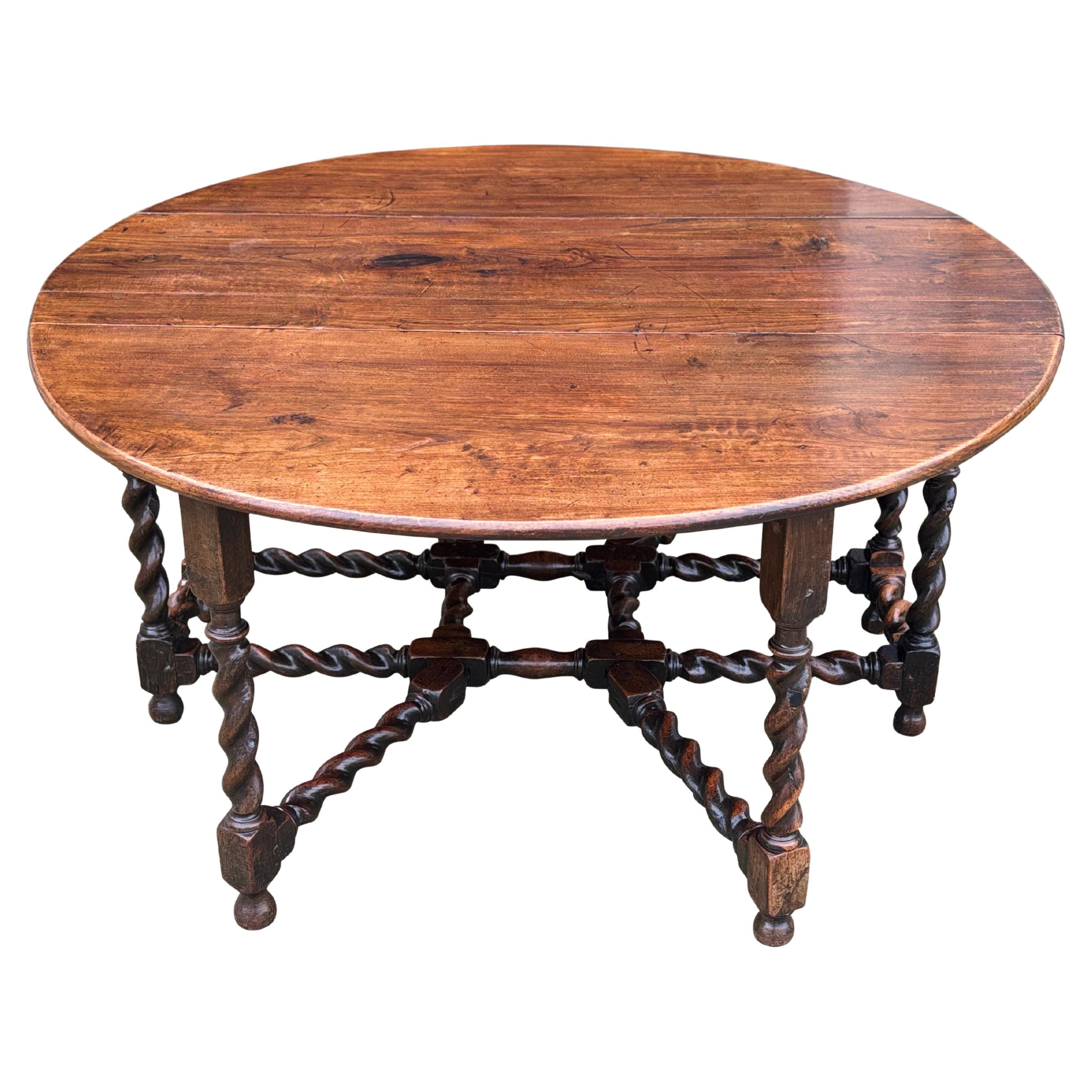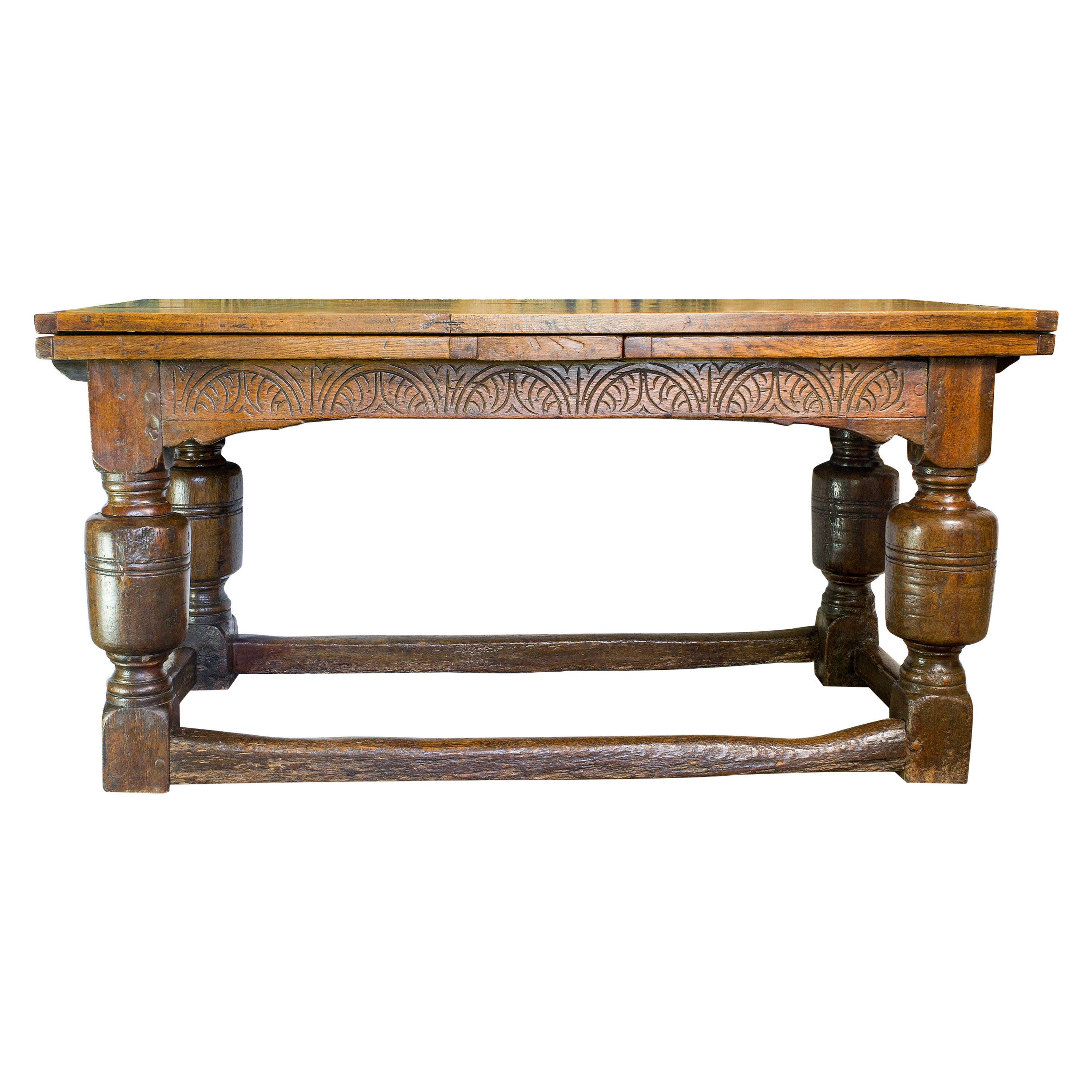Items Similar to 17th Century Oak Refectory Table, Charles II Period
Want more images or videos?
Request additional images or videos from the seller
1 of 7
17th Century Oak Refectory Table, Charles II Period
About the Item
A rare English 17th-century oak refectory table. Charles II period, ca 1675.
The three-plank cleated detachable top is of superb color, figuring and patination.
Raised on six baluster supports united by stretchers.
The frieze is guilloche-carved on all four sides: this demonstrates that this table can be free-standing. Many of these were only carved on three sides.
This versatile refectory table can be used as a hall table, dining table, serving table, or a wonderful kitchen table. A number of early oak pieces which we have sold have harmonized very well with modern interiors.
A similar-sized refectory table (in generally poor condition) sold for £17,000.00 plus buyer's premium, in Duke's auctioneers ATHELHAMPTON HOUSE sale, Puddletown, Dorset, UK, 9th Oct, 2019.
Nb. The turning of the supports on this antique table indicates a development away from an earlier, heavy, carved bulbous leg, to a simpler baluster leg of the later-seventeenth century. However the guilloche-carved frieze is a hint of an earlier period.
Some historic restoration commensurate with 350 years of use.
Dimensions:
8’5’' L. (256.5 cm)
2’8’' W. (81 cm)
2'7'’ H. (79 cm).
Literature:
R. W. Symonds 'The Present State of Old English Furniture', London (1921) fig. 5, dated 1675 - A very similar refectory table with strap carving.
Percy Macquoid 'A History of English Furniture Vol. 1, The Age of Oak and The Age of Walnut', Antique Collector’s Club Ltd, (1904) p. 208, fig. 177; ''An Oak Table. Property of the Duke of Devonshire''.
Percy Macquoid is notable as the first academic English furniture historian, and was co-author (with Ralph Edwards CBE FSA) of 'The Dictionary of English Furniture', Hamlyn (Fourth Impression 1972).
Nb.
In England these large refectory tables gradually gave way to smaller tables suited to the more intimate domestic arrangements coming into fashion after The Restoration of Charles II in 1660.
- Dimensions:Height: 31 in (78.74 cm)Width: 101 in (256.54 cm)Depth: 32 in (81.28 cm)
- Style:Charles II (Of the Period)
- Materials and Techniques:
- Period:1670-1679
- Date of Manufacture:circa 1675
- Condition:Repaired: A few historic repairs entirely commensurate with age. Wear consistent with age and use.
- Seller Location:Lymington, GB
- Reference Number:
About the Seller
5.0
Vetted Seller
These experienced sellers undergo a comprehensive evaluation by our team of in-house experts.
Established in 1957
1stDibs seller since 2018
33 sales on 1stDibs
Typical response time: 15 hours
- ShippingRetrieving quote...Ships From: Lymington, United Kingdom
- Return PolicyA return for this item may be initiated within 14 days of delivery.
More From This SellerView All
- 17th Century English Oak And Walnut ChestLocated in Lymington, GBAn English oak and walnut chest of drawers. Charles II period (1630-1685). The drawer fronts with walnut inserts of super colour. The substantial moulded top has cleated ends. Conta...Category
Antique 1660s English Charles II Commodes and Chests of Drawers
MaterialsOak
- Rare Charles II Period ChestLocated in Lymington, GBThis exceptional 17th-century chest / cabinet has one long working drawer, and one deep drawer, with cupboards retaining internal shelving below. All faced with elaborate, mitred, geometric mouldings, applied split balusters, carved corbels, roundels and engraved mother-of-pearl and bone panels. Some panels apparently in ebony. Dentil cornice to the frieze. Bun feet replaced following the original design. Great colour, old surfaces and overall condition is excellent. It conveniently divides into two sections. Circa 1660. Provenance: Lisgoole Abbey, N. Ireland. Literature: R. W. Symonds, 'The Present State of Old English Furniture', Duckworth, London (1921) fig. 7, dated 1673. Vis a very similar 17th c chest. Percy Macquoid RI, 'A History Of English Furniture - The Age Of Oak', Lawrence & Bullen, London (1904-08) p. 76, figs. 140 & 141, for two similar chests of ''well considered proportions and details’’. Figs. 203 - 210 exhibit further similarities in design, and MacQuoid states that “the fashion for these chests must have been great, as many varieties of them… followed rapidly upon one another in date” [sic] pp. 97-99. Viz p. 77, fig. 141 (Oak chest with drawers). The top opens in a long drawer, below is a very deep drawer, panelled in strong projection, the bevels of which are of so-called zebra or snake-wood. The lower portion of the chest, opening in two doors... [sic]. Nb. The chest illustrated in Macquoid is of oak, but in 1680 it was probably to match some other furniture, painted black and lacquered in what was then termed ''The Indian Taste'', so very fashionable for a time. The bone and pearl inlay is very cleverly imitated in the lacquer-work. Ralph Edwards CBE FSA, 'The Shorter Dictionary of English Furniture', Hamlyn, London (Fourth Impression 1972) “The next stage in the evolution (of the chest) was delayed until c. 1650, when a hybrid form, half cabinet and half chest...Category
Antique Mid-17th Century Charles II Commodes and Chests of Drawers
MaterialsOak, Bone
- Charles II Oak and Walnut Chest of DrawersLocated in Lymington, GBCharles II period (1630-1685) oak and walnut chest of drawers, or commode. Retaining old waxed surfaces of very good rich color and patination. With typical geometric drawer fronts and side runners, confirming a late 17th century date of c 1680. Walnut panel inserts to the drawer fronts. Retains its original stile feet and the base with its original bold moulding. Brass key escutcheons...Category
Antique 1680s English Charles II Commodes and Chests of Drawers
MaterialsOak, Walnut
- Large Regency Period Mahogany Dining TableLocated in Lymington, GBAn English Regency-period solid mahogany extending dining table of superb colour and figuring. Early-19th century, circa 1820. Retaining all of its original leaves of fine, well-figu...Category
Antique 1820s English Regency Dining Room Tables
MaterialsMahogany
- Fine Rare Pair 17th Century Oyster Walnut Chests on StandsLocated in Lymington, GBA fine, and rare, very closely-matched pair of late-17th century oyster walnut chests on stands. English, Charles II period, ca 1685. Both with f...Category
Antique 17th Century English Charles II Commodes and Chests of Drawers
MaterialsWalnut
- George III Period Satinwood Pembroke TableLocated in Lymington, GBA late 18th century satinwood Pembroke table of very good rich color. George III period. The top crossbanded in satinwood, bordered with fine lozenges of ebony stringing. The edges ebonized with narrow mahogany crossbandings. Raised on moulded tapering legs, indicative of a date circa 1770. The frieze with two working mahogany-lined short drawers retaining the original gilt-brass Rococo mounts. The two leaves are supported on the original recessed hinged ‘ear’ supports. Overall in lovely original state. Some minor historic marks entirely commensurate with its age. Very good patination. These antique Pembroke tables were designed to be versatile: as small supper tables; occasional tables; tea tables; or lamp tables - sometimes also referred to as ‘drop leaf’ or ‘sofa’ tables. The majority of these Georgian tables are raised on square tapering legs or, when of a later date, on turned legs. It is more unusual for a satinwood Pembroke table to be raised on moulded tapering legs. Interestingly, Thomas Sheraton (1751-1806) mentions the Pembroke table as follows: “a type of breakfast table from the name of the lady who first gave orders for one of them”, possibly referring to the Countess of Pembroke, of Wilton House, Salisbury, (1737-1831). A similar George III satinwood Pembroke table...Category
Antique 1770s English Tables
MaterialsSatinwood
You May Also Like
- 17th Century Oak Charles II Refectory TableLocated in Hoddesdon, GBA 17th-century Oak Charles II Refectory table, dating from 1660-1685, comfortably seats six people. It features turned legs with side and centre stretchers and a solid four-plank oak...Category
Antique 17th Century British Charles II Tables
MaterialsOak
- 17th Century, Charles i, Joined Oak Six-Leg Refectory Table, circa 1640Located in Leominster, GBWith an impressive two-plank and end-cleated top, the front frieze rail carved with strapwork and with oak leaf and scroll-carved spandrels, the rear frieze rail with simple run-moul...Category
Antique 17th Century British Renaissance Tables
MaterialsOak
- Antique 17th Century Charles II Country Oak Refectory Side Serving Table 1680Located in Portland, ORA good antique English 17th Century country oak refectory or serving table, circa 1680. The table dates from the reign of King Charles II, referred to as the Restoration period after...Category
Antique 1680s English Charles II Tables
MaterialsOak
- Large 17th Century Charles II Period Solid Oak Double Gateleg TableLocated in Petworth,West Sussex, GBA stunning mid 17th century, Charles II period, large solid oak double gateleg dining table. The oval plank oak top above bold barley twist turned uprights with matching twin knuckle...Category
Antique 17th Century British Charles II Dining Room Tables
MaterialsOak
- Antique Charles II 17th Century Carved 8ft Oak Refectory Dining table 1680Located in Portland, ORAntique English carved oak refectory dining table, circa 1680. A fine and large oak refectory table from the reign of King Charles II and the restoration of the monarcht after the En...Category
Antique 1680s English Charles II Dining Room Tables
MaterialsOak
- 17th Century, Charles I, Oak Draw Leaf Table, Circa 1640Located in Leominster, GBThe top of three fully-cleated boards, the two leaves of similar construction, all frieze rails carved with lunettes, raised on large plain bulbous 'cup-and-cover' turned legs, joine...Category
Antique Early 17th Century British Renaissance Tables
MaterialsOak
Recently Viewed
View AllMore Ways To Browse
Table Sale
Collectors Table
Tables On Sale
Small Stretcher Table
Club Side Table
Antique Side Tables London
Antique Side Table London
Side Table Six Legs
Antique Furniture London Uk
Dated 17th Century Furniture
English Early 17th Century Furniture
Antique Small English Table
Old English Oak
Old English Oak Furniture
Antique English 17th Century
Small Antique Oak Side Table
English Literature
Large Antique Kitchen Table





